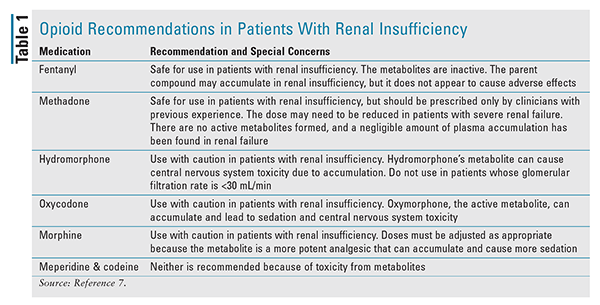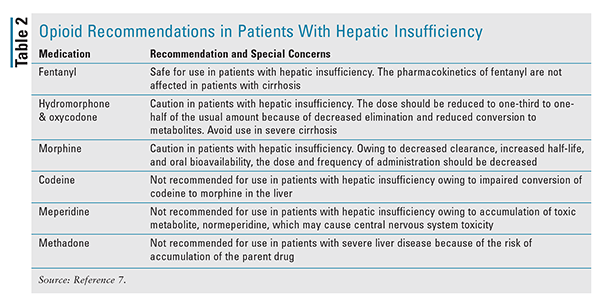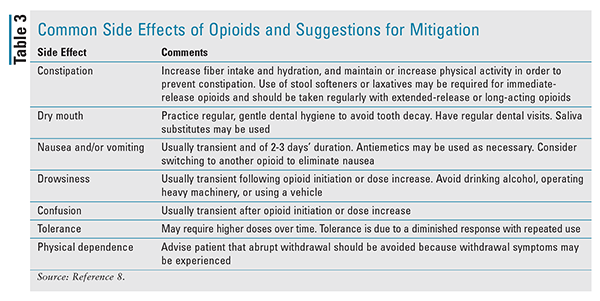US Pharm. 2018;43(3):26-30.
ABSTRACT: The CDC provides recommendations for clinicians as a guide for determining when to appropriately prescribe opioids for the treatment of chronic pain. It is commonly believed that elderly persons are less sensitive to pain and that experiencing pain is part of the aging process, but these assumptions result in possible undertreatment of pain. Special consideration must be given to elderly patients because of pharmacokinetic and pharmacodynamic changes in this age group. Pharmacists remain an important liaison between patients, caregivers, and other healthcare professionals. The role of the pharmacist is to ensure patient safety, as well as to provide counseling to help lessen the risk of potential side effects.
The CDC estimates that 20% of patients with noncancer pain symptoms or with acute or chronic pain-related diagnoses receive an opioid prescription.1 Pain affects approximately 100 million American adults each year, resulting in a national cost of $635 billion annually in medical treatment and loss of productivity.2 There is a lack of consensus among prescribers across the United States on the proper use of opioid pain medications. Certain patient populations, including ethnic minorities, pregnant women, elderly patients, and patients with cognitive impairment, may experience pain that goes untreated or unrecognized. In addition, cancer patients and patients nearing the end of life may not receive adequate pain control.
Chronic pain is described as typically lasting more than 3 months or extending beyond the time that is essential for normal tissue healing. Chronic pain may be due to an injury, inflammation, an underlying disease or condition, or unknown etiology. It is important for healthcare professionals to provide compassionate patient care and to understand that chronic pain is associated with clinical, social, and psychological consequences. Patients may experience reduced quality of life, limitations in complex activities, and social stigma. Prescribers should work with patients to achieve appropriate pain treatment based on a careful consideration of the benefits and risks of treatment options.1
Barriers to Treatment
Providing adequate pain-control treatment to patients with chronic pain may be met with some barriers. The reasons often stated by physicians for inadequate pain control include insufficient training, inappropriate pain assessment, and reluctance to prescribe opioids.3 Pain is subjective, so a comprehensive assessment of the patient’s level of pain should be performed prior to treatment.4 It is commonly believed that elderly persons are less sensitive to pain and that it is common to experience pain as part of the aging process; these assumptions lead to the possible undertreatment of pain. In addition, many elderly individuals may attach little importance to their pain in the face of other significant events, such as losing a spouse or their independence. The experience of losing a spouse, along with the attendant mourning and depression, has been associated with an increase in the likelihood of pain. Elderly persons may also have comorbidities that contribute to their pain, including diabetic neuropathies, compression fractures from osteoporosis, osteoarthritis, fall injuries, and impaired circulation.5
Special Considerations for Opioid Use in Elderly Patients
In the management of chronic pain, clinicians should consider nonpharmacologic therapy and nonopioid pharmacologic therapy before initiating opioids.1 Nonpharmacologic interventions include relaxation techniques, self-hypnosis, psychiatric therapy, local heat applications, cold massage, electrical nerve stimulation, and physical therapy. Nonopioid pharmacologic therapy may include antidepressants, antiarrhythmics, anticonvulsants, tranquilizers, and regional anesthesia.6
Opioid use should be implemented only when alleviation of pain and improvement of function outweigh the risks to the patient.1 The goals of chronic pain therapy are to decrease pain, increase function, and improve overall quality of life.4 Prevention and elimination of unnecessary suffering are the keys to successful management of chronic pain.6
Healthcare professionals should be cautious when prescribing and dispensing opioid medications to patients aged 65 years and older. Because of their age, elderly patients may have reduced renal function even in the absence of renal disease, thereby leading to a reduction in medication clearance. Since elderly patients may have an increased risk of drug accumulation because of decreased renal function, there is a narrow therapeutic window between dosages that are safe and those that could lead to respiratory depression or overdose.1 It is important that the physician monitor the patient’s glomerular filtration rate and creatinine to determine appropriate dosing.
The recommended opioids for patients with renal insufficiency are listed in TABLE 1. Patients with decreased hepatic function also must be closely monitored. The liver is responsible for the metabolism of opioids to their metabolites. Liver insufficiency can lead to an accumulation of the drug in the body; therefore, it may be necessary to adjust the dose and instruct caregivers and patients to allow longer administration intervals.7 Refer to TABLE 2 for a list of recommended opioids in patients with hepatic insufficiency.


Compared with younger adults, older patients have an increased risk of comorbid medical conditions, meaning that they have a higher likelihood of polypharmacy and drug-drug interactions with opioids. To help prevent medication-related errors such as duplicate therapy, it is recommended that healthcare professionals advise elderly patients receiving opioids against saving unused medications or going to multiple prescribers. Healthcare professionals should help reduce common risks of opioid therapy by assessing the risk of falls, monitoring patients with cognitive impairment, and providing exercise and bowel regimens to prevent constipation.1
Safe Prescribing Practices for Opioids in Elderly Patients
It is recommended that opioids be prescribed at the lowest effective dose, which is approximately 25% to 50% of the adult recommended starting dose, and then slowly titrated to minimize adverse effects for patients older than age 70 years.6 The dosage should be reassessed 1 to 4 weeks after initiation or dose escalation. Immediate-release formulations of opioids should be initiated before extended-release or long-acting opioids are attempted.1
Patient Education for Opioid Treatment of Chronic Pain
Pharmacists play an important role in educating patients about their medications, working with healthcare professionals to identify risks, and ensuring patient safety. TABLE 3 lists the common side effects of opioids and suggestions for mitigation. Patients and their caregivers should be informed about the expected benefits of opioids. Opioids reduce short-term pain, and complete pain relief may be unlikely with long-term use. It should be emphasized that the goal is functional improvement and that this can occur even in the presence of pain. Patients must be made aware of the potential for serious side effects, including fatal respiratory depression and the development of lifelong opioid-use disorder.8 Respiratory depression is a significant threat for opioid-treated patients with underlying pulmonary diseases who are receiving concomitant central nervous system drugs associated with hypoventilation.9 Patients should be advised to use caution when operating heavy machinery or a vehicle. It is especially important to take precautions when opioid doses are increased or when opioids are combined with benzodiazepines or sedatives. Alcohol intake should be avoided; it can impair cognitive function.

Another area of concern with opioid use in elderly patients is drug diversion or abuse by young adults who are friends or relatives. Inform patients of the risks to other household members and advise them that the prescribed medications must not be shared. It is preferable to keep the medications locked in a secure storage device. In addition, pharmacists and prescribers should monitor how frequently the opioid prescriptions are being filled or if the patient is often accompanied by younger adults to the pharmacy or to office visits.8 Some signs of greater risk of addiction or opioid misuse include a history of alcohol or drug addiction and a history of depression or anxiety. Patients can be monitored with urine drug screens. Also, in order to monitor compliance, prescribers can ask patients to bring in their bottles for a pill count during their regular office visits.10 It is important that patients be periodically reassessed by their healthcare professionals to ensure that goals are being met and to consider alternatives if opioids are not effective or are harmful to the patient. Finally, patients should be made aware of the availability of naloxone for overdose reversal.8
Conclusion
CDC guidelines for opioids provide valuable recommendations on how to safely prescribe these medications. The pharmacist is a liaison between patients, caregivers, and other healthcare professionals and is critically positioned to help patients by providing medication counseling. The role of the pharmacist is to ensure that best practices are used in order to provide optimal care for patients in the community. It is important for the pharmacist to be cognizant that elderly patients have special considerations that may require extra attention to make certain that the treatment goals are being met.
REFERENCES
1. Dowell D, Haegerich TM, Chou R. CDC guideline for prescribing opioids for chronic pain—United States, 2016. MMWR Recomm Rep. 2016;65:1-49.
2. Institute of Medicine. Relieving pain in America: a blueprint for transforming prevention, care, education, and research. June 2011. www.nap.edu/resource/13172/reportbrief.pdf. Accessed December 2, 2017.
3. Cavalieri T. Managing pain in geriatric patients. J Am Osteopathic Assoc. 2007;107:ES1-ES16.
4. Throm MJ, Fudin J, Otis JA. Managing chronic pain: an analysis of the use of opioids. www.pharmacytimes.com/publications/issue/2005/2005-07/2005-07-9738. Accessed December 2, 2017.
5. Asih S, Hulla R, Hartzell M, Bradford E, et al. Pain management in the elderly: etiology and special considerations. www.practicalpainmanagement.com/treatments/pain-management-elderly-etiology-special-considerations. Accessed December 2, 2017.
6. Koda-Kimble M, Young L. Applied Therapeutics: The Clinical Use of Drugs. 7th ed. Philadelphia, PA: Lippincott Williams & Wilkins; 2001.
7. Carbonara GM. Opioids in patients with renal or hepatic dysfunction. www.practicalpainmanagement.com/treatments/pharmacological/opioids/opioids-patients-renal-hepatic-dysfunction. Accessed December 2, 2017.
8. Holle LM. Pharmacist perspective on the CDC guideline for prescribing opioids for chronic pain. www.modernmedicine.com/sites/default/files/images/DrugTopics/UCONN/drtp0317_CE.pdf. Accessed December 2, 2017.
9. Pergolizzi J1, Böger RH, Budd K, et al. Opioids and the management of chronic severe pain in the elderly: consensus statement of an International Expert Panel with focus on the six clinically most often used World Health Organization Step III opioids (buprenorphine, fentanyl, hydromorphone, methadone, morphine, oxycodone). Pain Pract. 2008;8:287-313.
10. National Initiative for the Care of the Elderly. Opioids, benzodiazepines and the elderly: a pocket guide. www.nicenet.ca/de.aspx?id=499. Accessed February 13, 2018.
To comment on this article, contact rdavidson@uspharmacist.com.






